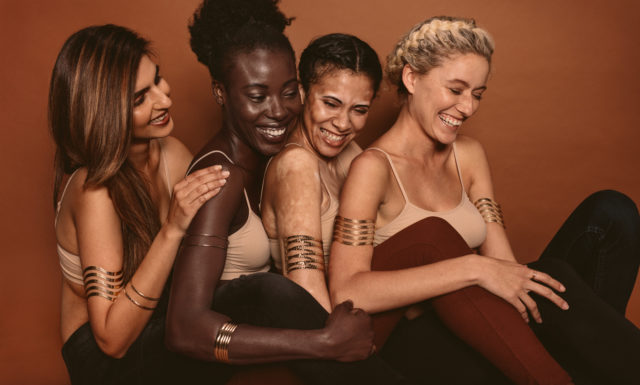
Like many of us, growing up, I was obsessed with the idea of falling in love. Thanks to the media, I was inundated with images of couples falling in love and getting married. But when I pictured it for myself, I didn’t have a consistent imagined partner. (What can I say? I was queer before I had the language to claim the label for myself!) Yet there was one thing that was consistent: Always having “The One.”
It’s not an accident, either. Our society is saturated with this idea that love is reserved only for pairs. We’re meant to go out into the world and find our soulmate: that one special person, out of millions, who understands us better than anyone else.
But what does it mean when the idea of love includes more than one person, at the same time?
Polyamory is a term understood to be “the capacity to love more than one person at a time.” It has been around for as long as humans have been loving and living. So why is there still so much confusion surrounding poly people?
Given that polyamory has been around for so long, it’s weird that it’s only gaining popularity now, especially among queer people. There are a lot of misconceptions about how legitimate polyamory actually is. It’s often seen as nothing more than the new dating trend: something that millennials are doing to seem cool and nonchalant and to avoid attachment and commitment. But this couldn’t be further from the truth. Just as there is no ‘one size fits all’ way to be monogamous, there are multiple ways to be polyamorous and to practice polyamory.
For queer people, especially, polyamory is important because it’s one more way that we can reclaim power over how we love and what our love looks like. Polyamory is an announcement to the world that sometimes love can be too vast to contain in a partnership between only two people. And it’s as valid as imagining your dream relationship with just one person for the rest of your life.
So let’s go over a few of the most popular misconceptions about polyamory, and how we can begin to debunk them:
Wasn’t the bicycle built for two?
Polyamory gets a bad reputation because of societal influence. We’re obsessed with the idea of duos: male or female, left or right, this or that, single or taken. We’re taught from a young age to choose between two options, without stopping to wonder if there are more options to choose from.
Let’s begin to imagine that if we have free rein to choose among the infinite possibilities of what we wear, how we style our hair, how we do our makeup, what music we listen to, and what we eat for dinner, that freedom of choice also applies to how we express our love. There are infinite ways to express ourselves in the world. So to help expand those ideas, it’s important that polyamory is seen as a valid expression of romantic love and intimate relationships.
Let’s talk about sex, baby…
Another big misconception about polyamory is the idea that it’s all about sex. Although sex is fantastic and messy and fun, that’s not all that makes a relationship. Remember that there are many different ways to practice polyamory. Sometimes this includes people who use their polyamory to focus on sex, which is fine and valid. But it’s important to realize that this isn’t the case for all polyamorous people.
Assuming that all polyamorous people are polyamorous only because they want to have a lot of sex is an incorrect and dangerous misconception. That assumption is also harmful because it punishes a community for not conforming to the cultural norm of monogamy. In order to have an inclusive, sex-positive society, we have to be open and accepting of all relationship styles—even if they aren’t how we personally practice and express love.
Labels matter… and don’t.
There are also numerous different ways that polyamorous people identify themselves. There’s non-monogamous, solo-poly, triad, quads, relationship anarchy, and many more. Some people consider polyamory to be a solid identifier in its own right, while others prefer specific labels that speak more specifically to their experiences. It’s also important to remember that all those other identities we carry—race, gender, sexuality, ability, class—impact our views and practices of what polyamory looks like. Being mindful of that, even if we aren’t polyamorous ourselves, is a small practice to help legitimize polyamory in our own circles.
It’s not a quick fix.
The popularity of polyamory means that more people are openly talking about it and trying to see if this relationship style works for them. And that’s GREAT. But that also means that there are more people having trouble navigating polyamory when it doesn’t work for them.
Let’s be clear. Seeing polyamory as a valid relationship structure means understanding that it’s not going to be a quick fix to your current relationship. Adding in another person won’t solve the issues of your existing relationship. It will likely only exacerbate them. Previously monogamous couples that “open up” their relationship, without doing the individual and collective work to lay out how polyamory will impact their lives, will cause more harm than good, ultimately.
So if you’re wondering if polyamory is right for you, do your research. Do the individual work to define these terms for yourself, and don’t go into it expecting a quick fix for a deeper issue.
Polyamory is a valid, specific relationship style that deserves our respect. It’s rooted in queer history and has existed for as long as we have existed. To reduce and diminish polyamory as nothing more than “the latest trend” isn’t fair. It is a valid, powerful relationship structure. And it’s time for us think of it as such.

What Do You Think?